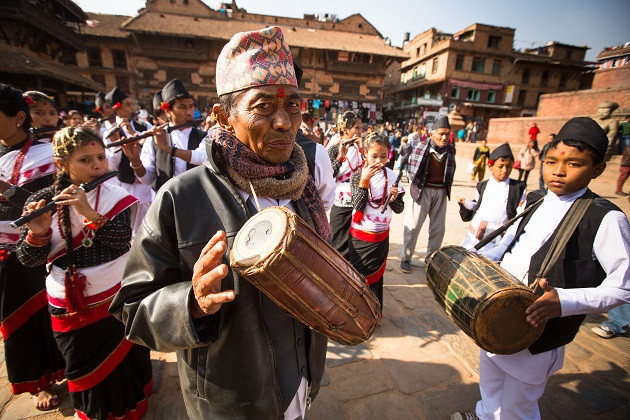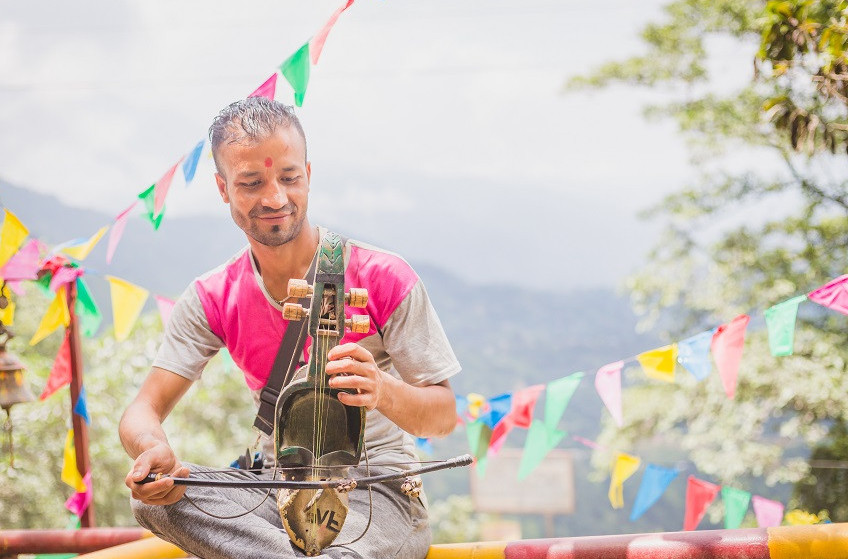For a country with a rich culture like Nepal, music is a very important aspect of life. In rural areas in particular, you will come across many villagers who like singing or gathering around someone playing an instrument in the evening. Nepalese know many songs and actually often can and like singing them as well, arranging their own entertainment. 
Traditional music group, playing the madal (drum) and bansuri (flute)
Music instruments of Nepal; amazing sounds
The madal, like in the picture above, is a folk musical instrument of Nepal that you will find throughout the country anywhere where people are playing folk music. It is a hand drum which is mainly used for rhythm-keeping accompanying songs and dance. The madal consists of a cylindrical body with at both ends a slight bulge at its center and heads, of which one head is larger than the other. It is usually played horizontally in a seated position, with both heads played simultaneously.
Another traditional Nepalese music instrument that is at the heart of traditional folk music performances is the sarangi, like shown in the picture below. This is a small fiddle which is used in folk music throughout South Asia. It is a short-necked instrument with three melody strings that are made of gut.

Sarangi
The bansuri is a side-blown flute, traditionally made of bamboo, widely used in India and Nepal. It is a traditional instrument already depicted in ancient Buddhist, Hindu and Jain religious icons, paintings and reliefs. The bansuri is revered as Lord Krishna’s divine instrument.
The fact that the bansuri is a very portable instrument of 2.5-3 feet length, made from a single hollow shaft of bamboo with six or seven finger holes, makes it easy to be carried and taken along. The instrument covers two and a half octaves of music. One end of the bansuri is closed, and its blow hole is few centimeters from the closed end. Longer bansuris feature deeper tones and lower pitches.
Explore the different music genres; from classical to folk…something for everyone
As Nepal has more than fifty ethnic groups, its music is also highly diverse. Some of the main genres that are widely played are linked to specific ethnic or language groups like Tamang Selo, Maithili, Gurung, and Newa, others genres like Dohori, Bhajan, and Classical music are generally applied by all ethnic groups in the country. Musical genres from Tibet and India have greatly influenced Nepalese music.
Tamang Selo is music by the Tamang people of Nepal and is widely popular among the Nepali-speaking community. Typical instruments that accompany this music are the damphu, madal and tungna. The Madal we have seen in the picture above. A Damphu is a percussion instrument, like a large tambourine, and the tungna a small string instrument made from a single piece of carved wood. The front hollow body of the tunga is covered with stretched animal skin on which the ‘bridge’ is fitted.
Dohori folk songs are usually sung by two teams of men and women, and originated in the rural areas of Nepal. In this type of folk songs, one team sings a question and the other team replies with a couplet and vice versa. In Nepali, Dohori means ‘back and forth’ and relates to an exchange of phrases between the contesting groups of collaborating singers. The groups of men and women sit on opposite sides and keep on improvising, teasing and flirting with each other in the improvised verses, until one of the team runs out of answers.
Bhajan music refers to songs with a religious spiritual theme, which is widely applied in the Hindu religion.
Classical music in Nepal used to be promoted and protected by Nepal’s rulers, in the courts of the Mallas and Shah Kings and the Ranas, who also had classical music as part of their training.
Nepali classical music is closely linked to Indian classical music, and similar instruments are used with a center place for the sitar and the tabla.
The sitar is a plucked string instrument with a long neck. It can have 18, 19, 20, or 21 strings. Six or seven of the strings are played strings running over curved frets that are raised. The other strings run underneath the frets, resonating with the played strings.
“Nepal Sitars” is group of three professional Nepali classical musicians from Kathmandu. Among them sitarist Satendra Man Singh Tuladhar, son of Tara Bir Singh Tuladhar of the famous Nepalese Folk Music group Sur Sudha. On the website of “Nepal Sitars” (nepalsitars.com) you can find information on sitar classes as well.
The tabla is a set of two rounded metal or ceramic drums with skin heads lashed on by leather thongs. It can produce an amazing range of sounds by striking the center, edge, or breadth of the drum. In addition, the bansuri (discussed above) is one of the other instruments frequently used in Nepali classical music.
There is also one typical European instrument imported in Nepali music, the harmonium. It is not so much used as solo instrument but more to accompany songs.
Traditional music performances; where to find them
Traditionally, there are several musician castes who perform in bands or individually. Nowadays, cultural practices have loosened a bit with people from other castes also involved in the music scene. To experience traditional Nepalese music, you can either listen to some recordings or visit a life performance.
If you like to take some recordings of traditional Nepalese folk music home, look for recordings from the group Sur Sudha , their album “Festivals of Nepal” is available on Amazon.
As its name already indicates, this album reflects the own tune of several of Nepal’s main festivals. You will hear the tabla (hand drum), bansuri (flute) and sitar expressing the variety of Nepalese traditional music. Music from this album is also very suitable to use as background music for any video you might have made of your visit to Nepal.
If you are more in to vocal music, you can listen to the Ani Choying Drolma, a famous singing Nepalese Buddhist nun of Tibetan origin. Another recommended singer is Narayan Gopal, who is widely regarded by many Nepalese as their best folk-singer ever. He is also referred to as “Swar Samrat”, which means “Emperor of Voice”. His songs are accompanied by traditional instruments like the sitar, harmonium and bansuri.
Get active with traditional music of Nepal yourself
Well, you can get “active” with traditional music of Nepal by listening to it on recordings or at Spotify. There is a playlist of “traditional Nepalese music”, which features music with many of the instruments mentioned in this blog. You can access it at Spotyify through the following link; Traditional Music of Nepal
There are also various places, particularly in the Kathmandu valley and Pokhara, where you can learn to play traditional Nepalese instruments. A good start for your search for such classes is http://musicroomktm.com/classes . They have a section for classes where you can learn playing eastern instruments, and have options for online classes for students outside Nepal.
